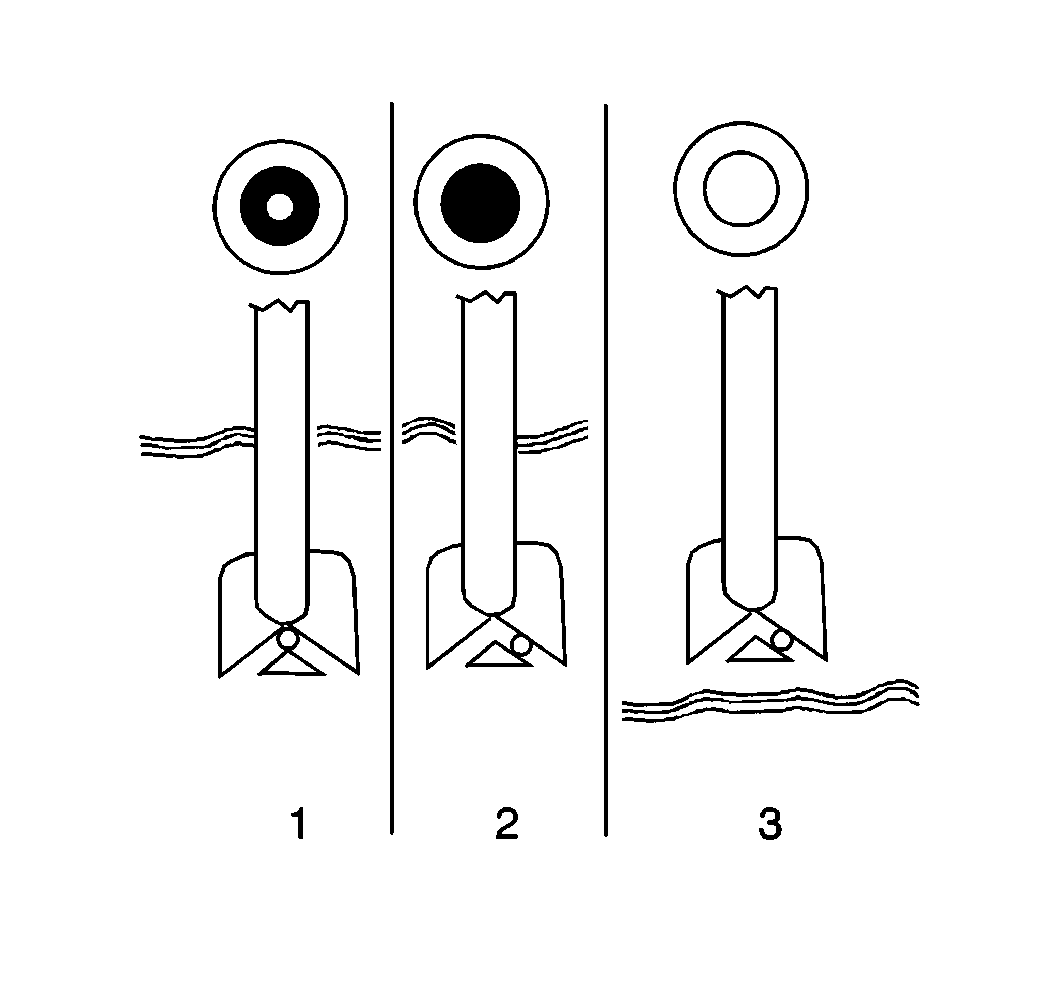
Caution: Unless directed otherwise, the ignition and start switch must be in the OFF or LOCK position, and all electrical loads must be OFF before servicing
any electrical component. Disconnect the negative battery cable to prevent an electrical spark should a tool or equipment come in contact with an exposed electrical terminal. Failure to follow these precautions may result in personal injury and/or damage to
the vehicle or its components.
Notice: Do not use the boost, jump start, crank, or an equivalent
setting that may be available on the battery charger for prolonged charging
of the battery. Using such settings may damage the battery due to overheating,
excessive gassing, or spewing of electrolyte from the vents.
| • | Follow these basic rules when charging a battery: |
| • | Batteries showing a green dot in the hydrometer (1) do not need
to be charged unless they have just been discharged (such as cranking the
engine). |
| • | Batteries showing a black or dark dot in the hydrometer (2) can
be charged. |
| • | Do not charge the battery (3). Replace the battery if the built
in hydrometer is clear or light yellow and there is a cranking problem. A
clear or light yellow hydrometer indicates a low electrolyte level in the
battery. |
| • | To keep charge time to a minimum, use a charger capable of an
end voltage of at least 16 volts and equipped with a voltmeter that
is accurate to within 1 percent. |
| • | Do not use boost, jump start, crank, or an equivalent setting
for prolonged charging of the battery. Undesirable and potentially dangerous
spewing of gasses or electrolyte through the vent holes may occur. |
| • | The ambient temperature should be 15-38°C (60-100°F).
A battery that is extremely cold will not accept measurable current for several
hours after starting the charger. |
| • | The charging area should be well ventilated. |
| • | Do not charge a battery that appears to be frozen. Replace any
frozen battery. Refer to
Battery Replacement
. |
| • | Check the battery being charged every 30 minutes to avoid
overcharging the battery. |
| • | If during charging the battery feels hot, 52°C (125°F),
or if gassing or spewing of the electrolyte through the vent holes occurs,
discontinue the charging or reduce the charging rate. |
| • | Stop charging within one hour after the green dot appears in the
hydrometer. |
Charging Time Required
The time required to charge a battery will vary depending upon the following
factors:
- The size of the battery -- A completely discharged, large,
heavy-duty battery requires more than twice the recharging time as a
completely discharged, smaller capacity battery.
- The temperature -- A longer time is needed to charge any
battery at -18°C (0°F) than at 27°C (80°F). When a fast
charger is connected to a cold battery, the current accepted by the battery
is very low at first. As the battery warms, the battery accepts current
at a higher rate.
- The charging capacity -- The higher the charger amperage,
the faster the battery will charge.
- The state-of-charge -- A completely discharged battery requires
more than twice as much charge time as a half charged battery. Because the
electrolyte is nearly pure water and a poor conductor in a completely discharged
battery, the battery accepts very low current at first. Later, as the charging
current causes the electrolyte acid content to increase, the charging current
also increases.
Charging Procedure
Tools Required
GM P/N 12303040 ST-1201
Battery Side Terminal Adapter (Pair)
Caution: Unless directed otherwise, the ignition and start switch must be in the OFF or LOCK position, and all electrical loads must be OFF before servicing
any electrical component. Disconnect the negative battery cable to prevent an electrical spark should a tool or equipment come in contact with an exposed electrical terminal. Failure to follow these precautions may result in personal injury and/or damage to
the vehicle or its components.
Notice: Do not use the boost, jump start, crank, or an equivalent
setting that may be available on the battery charger for prolonged charging
of the battery. Using such settings may damage the battery due to overheating,
excessive gassing, or spewing of electrolyte from the vents.
- Do not charge a battery with a clear or light yellow hydrometer.
Replace the battery. Refer to
Battery Replacement
.
- Do not charge a battery with a green hydrometer dot unless it
has just been discharged, such as in cranking the engine.
- When charging side-terminal batteries while on-vehicle, use the
following procedure:
| 3.1. | Turn OFF the charger. |
| 3.2. | Connect the charger positive lead to the positive booster cable
terminal. |
| 3.3. | Connect the negative charger lead to a solid engine ground. |

- When charging side-terminal
batteries out of the vehicle, install a terminal adapter kit (AC Delco P/N
ST-1201, GM P/N 123033040, or equivalent). The terminals must be tight
against the lead terminals of the battery to prevent excessive resistance
between the adapters and the terminals.
- Make sure all the battery terminals are clean and tight.
- A 40-50 ampere charging level is recommended for
a discharged battery.
- Charge the battery until the hydrometer has a green dot.
- Inspect the battery every half hour after starting the battery
charger.
- Tap the hydrometer lightly to dislodge any air bubbles. The bubbles
can cause a false indication.
- Test the battery after charging. Refer to
Battery Check
.


